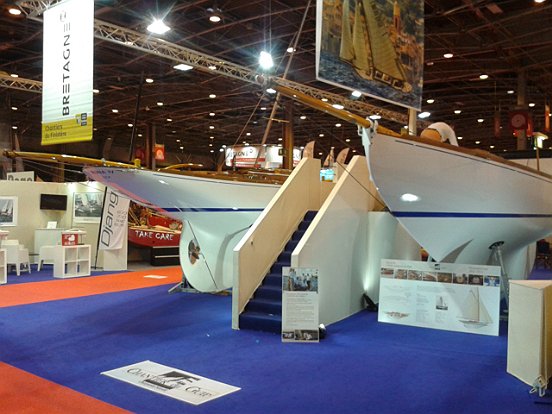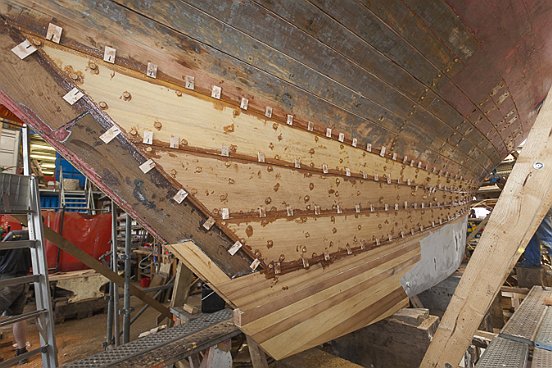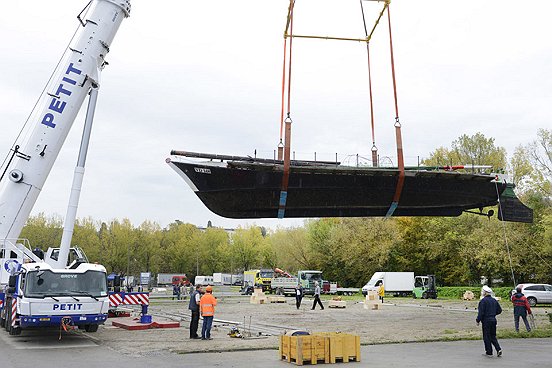
Guip Shipyard is internationally-recognized for its work on heritage vessels, in particular its rebuilds and restorations. The expert shipwrights from Brittany will be presenting some of their proudest moments at the forthcoming Paris Boat Show.
Three boats will be on show: two classic yachts rebuilt by the shipyard, Runa IV (10.70 m) and Runa VI (10.37 m), and the raid boat Izenah.
In total there have been seven yachts called Runa, each designed by Danish architect Gerhard Rønne between 1910–1920. The two on display were owned by classic yacht enthusiast Yves Carcelle who carried out an investigation worthy of Sherlock Holmes to track them down, and then he set about restoring them to their former glory.
Historian Jacque Taglang, who will be on the Guip stand in the company of designer François Chevalier, tells the story of these boats in his book La Saga des Runa. Both men contributed greatly to Guip’s work, providing precise archive information during the rebuilds. Visitors to the boat show will be able to view the result first hand, in particular a raised platform next to the boats will allow them to admire the deck layouts from above.
Izenah belongs to a completely different category of boat. Guip boss Yann Mauffret designed this elegant clinker raid boat with mahogany planks copper-riveted to locust frames. Her presence at the Paris Boat Show is a respectful nod to the early days of the shipyard, founded 1976, in a little creek called Guip on the Morbihan island of Île-aux-Moines. Izenah is, after all, a contraction of the Breton words Eniz-Venah, which means literally “Monk Island” or in French to make the relationship to Guip clearer, Île-aux-Moines.
She’s 4.62 m long, has a 1.65 m beam, her rudder and centreboard can be raised, and she weighs 210 kg. Izenah’s generous volume makes her a comfortable, safe boat and with her simple catboat rig (single lugsail), she’s easy to handle too.
Paris Boat Show, Porte de Versailles, 5–14 December. Stand 1 J 41.

Les Voiles de Saint-Tropez is without a shadow of a doubt a wonderful annual event for classic boat lovers. Once again Guip Shipyard was out on the water from 27 September to 5 October, and not just with Runa VI.
With Louis Mauffret at the helm, Runa VI cut a fine figure in her three category events and, despite the stiff competition, managed a respectable fourth place. In addition to the pleasure of racing a boat rebuilt with their own hands, Guip’s shipwrights were also delighted to see on the water about a dozen vessels which at one time or another have benefitted from the yard’s services. Yachts such as the 12 m IRs Wings (1937) and Vanity V (1936), the schooner Morwenna (1914, relaunched last year), the gaff cutter Lulu (1897), the Bermudian sloop Noryema IV (1965) and Tigris (1897).
Magnificent sailing yachts that make Guip Shipyard proud.

Okay, it wasn’t a matter of minutes, but getting Tigris ready for Les Voiles du Saint-Tropez was a challenge because the works had to be done in record time. And the fact that this was for an English customer just goes to show the international character of Guip’s reputation.
Tigris is a 16 m gaff cutter, built in 1899 at the MacAllister Yard in Scotland from plans by Alfred Mylne. She used to race regularly on the Clyde in a special 35’ class.
Entering Guip Shipyard last May, Tigris went back in the water in August after a major rebuild, including a new keel, floor timbers, and bottom planking, and works to strengthen the mast step! The rebuild was carried out in collaboration with architect Guy Ribadeau-Dumas and under the watchful eye of skipper Eduardo Niveyro, who was sent over to Brittany especially by the English owner.
Ready just in time for Les Voiles de Saint-Tropez!

Nothing military about this general because she’s a scallop-fishing boat from Brest, built in 1948 at Rostellec by the Auguste Tertu Yard.
A fine image of this type of vessel can be seen on the cover of Volume 3 of Ar Vag, the definitive history of all things related to Brittany and the sea. It shows the power and harmony of these scallop-fishing sloops as they return with heavy holds, sailing side by side, the wind astern, and their mainsails, topsails and jibs full to bursting.
The 15-tonne General Leclerc is 11.40 m long and has a 4.05 m beam. She retired from fishing for scallops in the waters off Brest in 1973. She was given a new lease of life as a leisure sailing boat in 1987 by the sailing trust Lenn Vor (meaning “roadstead” in Breton) but her hull is in a poor state and requires an almost total rebuild. She’ll be staying with Guip until next summer before going back in the water with a spring in her keel!

Guip Shipyard has sent off no fewer than six shipwrights to Switzerland to carry out the major rebuild of a Lake Geneva barge.
There was no way for a vessel of her size to be brought to the yard because the Vaudoise, built 1932, weighs a hefty 25 tonnes. With an overall length of 22.65 m, she’s the last remaining barge built on the shores of Lake Geneva. These vessels used to carry general cargo of up to thirty tonnes. Elegant—you could even say majestic—with two lateen sails, jib, clipper bow and flaired topsides, the Vaudoise must have been a sight to admire when long ago she was called the Violette and sailed across the lake, with a full cargo of stone, her rail kissing the surface of the water.
In 1948 her work dried up. In the same year she was bought by sailing trust La Confrérie des Pirates d’Ouchy with a view to keeping the last remaining lateen-rigged barge sailing on Lake Geneva, and the trust renamed her the Vaudoise.
And there’s much work to do if a once-familiar craft is to continue furrowing the surface of the Helvetian water. She’ll be getting a new keel, new hull planking and two new raked masts before she goes back in the water. And when she does, Switzerland’s heritage will breathe a sough of satisfaction.

